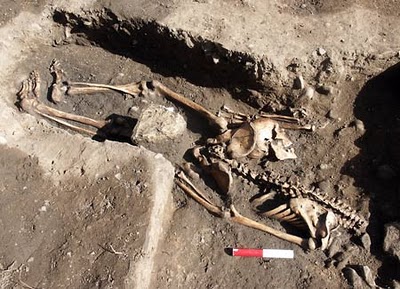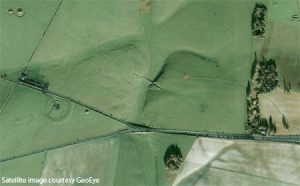 Tickets go on sale today for “Secrets of the Silk Road” a landmark exhibition from China making its only East Coast stop at the University of Pennsylvania Museum of Archaeology and Anthropology (Penn Museum) in Philadelphia February 5 through June 5, 2011. The exhibition aims to reflect the wide extent of the Silk Road trade and cultural interchange (see some of the highlights in this slideshow).
Tickets go on sale today for “Secrets of the Silk Road” a landmark exhibition from China making its only East Coast stop at the University of Pennsylvania Museum of Archaeology and Anthropology (Penn Museum) in Philadelphia February 5 through June 5, 2011. The exhibition aims to reflect the wide extent of the Silk Road trade and cultural interchange (see some of the highlights in this slideshow).
Despite of what its name suggests, the Silk Road isn’t one single route. Rather, it is an extensive interconnected network of maritime and overland trade routes extending from Southern Europe through The Arabian Peninsula, Somalia, Egypt, Iran, Pakistan, India, Bangladesh, Java-Indonesia, and Vietnam until it reaches China.
This travelling exhibition of materials from half way around the world is opening new doors providing visitors with an unparalleled opportunity to come face to face, literally, with life in East Central Asia, both before and after the formation of the fabled Silk Routes, noted Victor Mair, University of Pennsylvania scholar, and curatorial consultant and catalogue editor for the exhibition.
The Secret of Silk
Although recent archaeological evidence a small ivory cup carved with a silkworm design as well as spinning tools, silk thread and fabric fragments is dated to between 4000 and 5000 BC,it is still generally assumedsilk production started in China somewherein thelate 4th millennium BC.
About 500 years later, the domestication of pack animals (we wouldn’t learn to ride until the 1st millennium BC) and the development of shipping technology increased the capacity for prehistoric peoples to carry heavier loads over greater distances; trade started to develop rapidly.
It were not just goods that were exchanged along the first trade routes. Over the centuries, many different peoples controlled parts of the Silk Routes, all using it to spread their technology, ideas, believes and art.
Even before the 1st century AD, the earliest evidence ofsilk reaching Rome, Alexander the Great took the Greek culture into Central AsiawithGraeco-Buddhism as result.
Yet the well-guarded secret of sericulture or silk production did not spread at all.(Recent research does show the possibility that silk production started independently in the Indus Valley, around 2000BC.)
Roman historian Pliny the Elder wrote in his Natural History in 70 BC that “silk was obtained by removing the down from the leaves with the help of water”.
The secret of silk production reached the Middle East only in the 6th century AD, when two monks appeared at Emperor Justinian’s court hiding silkworm eggs in their hollow sticks.
And Europe? It wasn’t until the 13th century that Italy began that Italy began silk production with the introduction of 2000 skilled silk weavers from Constantinople (once Byzantium, modern day Istanbul).
Even then, high-quality silk textiles woven in China would continue to be highly valued in the West, and the trade along the Silk Route continued as before.
TheBeauty of Xiaohe
The appearance of the 3,800 year old Beauty of Xiaohe, one of two strikingly well preserved ‘caucasian’Tarim mummies and their associated artefacts travelling from China, makes “Secrets of the Silk Road” an exhibition that reaches back well beyond the historic period of the Silk Road to tell a tale of long-forgotten peoples and cultures along the worlds legendary trading route.
Tall in stature and fair in complexion, the Beauty was excavated in 2003 (listed as one ofour’Top 10 Most Important Archaeology Finds in China… ever‘). She is one of hundreds of spectacularly preserved mummies, many with surprisingly Eastern European and Mediterranean features, buried in the harsh desert sands of the vast Tarim Basin of Central Asia, in the Far Western Xinjiang Uyghur Autonomous Region of China.
The Beauty of Xiaohe, will be shown along with a bundled baby mummy dated to the 8th century BC, and the complete trappings of Yingpan Man, a six-foot six-inch mummy, from the 3rd to 4th centuries AD.
The Wide Extent of the Silk Road
Besides the mummies, the exhibition features a wide range of objects, 700 to 3,800 years. Objects include well-preserved clothing, textiles, jewellery, gem-encrusted gold vessels, wood and bone implements, coins and documents even preserved foods (2,500-year-old fried dough and flower-shaped desserts).
Organized by the Bowers Museum, Santa Ana, California in association with the Archaeological Institute of Xinjiang and the Urumqi Museum, “Secrets of the Silk Road” began its U.S. tour at the Bowers Museum (March 27 to July 25) before traveling to the Houston Museum of Natural Sciences, where it is on view through January 2, 2011.
Timed tickets for the Secrets of the Silk Road exhibition at the Penn Museum can be purchased online at www.penn.museum/silkroad or by phone: (877)77-CLICK. Discounted group tickets are available by phone: (215)746-8183, or by email: grouptickets@museum.upenn.edu.
Teacher programs, including a Thursday, November 4 Educators’ Evening, 4:30 to 6:30 pm, are available through the Museum’s Community Engagement Office: (215)898-4015. Teacher materials will be available online starting December 15.













